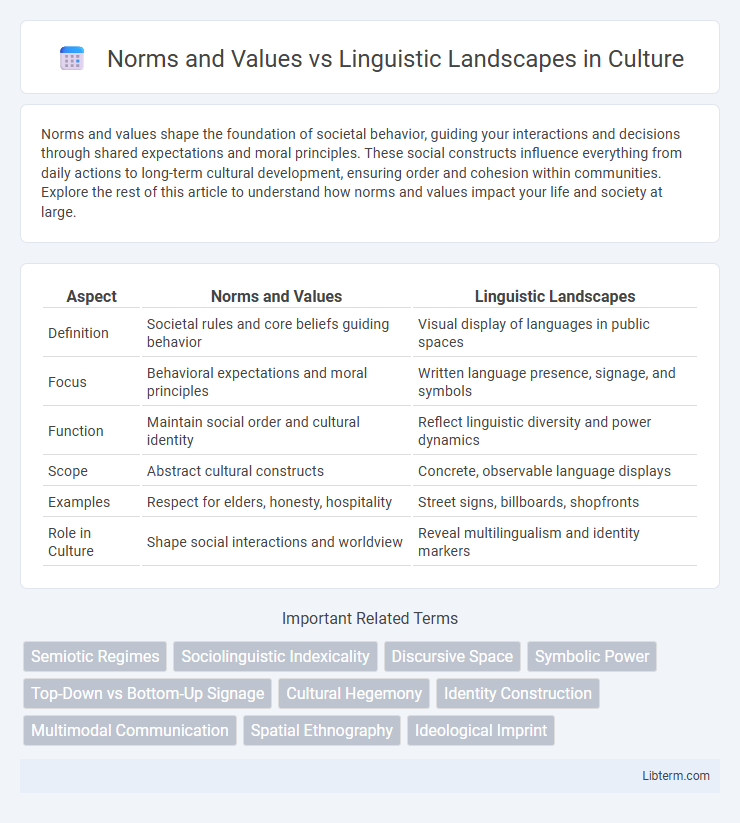Norms and values shape the foundation of societal behavior, guiding your interactions and decisions through shared expectations and moral principles. These social constructs influence everything from daily actions to long-term cultural development, ensuring order and cohesion within communities. Explore the rest of this article to understand how norms and values impact your life and society at large.
Table of Comparison
| Aspect | Norms and Values | Linguistic Landscapes |
|---|---|---|
| Definition | Societal rules and core beliefs guiding behavior | Visual display of languages in public spaces |
| Focus | Behavioral expectations and moral principles | Written language presence, signage, and symbols |
| Function | Maintain social order and cultural identity | Reflect linguistic diversity and power dynamics |
| Scope | Abstract cultural constructs | Concrete, observable language displays |
| Examples | Respect for elders, honesty, hospitality | Street signs, billboards, shopfronts |
| Role in Culture | Shape social interactions and worldview | Reveal multilingualism and identity markers |
Introduction to Norms and Values
Norms and values form the foundational principles that guide social behavior and cultural expectations within a community, shaping individuals' perceptions and interactions. These social constructs influence the messages conveyed through linguistic landscapes--public displays of language such as signs, advertisements, and graffiti--which reflect and reinforce the dominant cultural ideologies. Understanding norms and values is essential for interpreting linguistic landscapes as they reveal underlying social priorities and power dynamics embedded within public language use.
Defining Linguistic Landscapes
Linguistic landscapes refer to the visible display of language in public spaces, including signs, billboards, graffiti, and other textual elements that reflect the linguistic and cultural identity of a community. These landscapes serve as a powerful medium for expressing social norms, values, and power dynamics within a given society. By analyzing linguistic landscapes, researchers can uncover how language use in public signage influences social behavior and reinforces or challenges cultural norms and values.
The Interplay between Language and Culture
Norms and values shape the linguistic landscapes by influencing how language reflects cultural identity in public spaces through signs, symbols, and inscriptions. The linguistic landscape serves as a dynamic representation of societal beliefs, where language use in public domains reveals underlying cultural norms and values. This interplay highlights how language both constructs and is constructed by cultural contexts, reinforcing community identity and social cohesion.
How Norms Shape Public Language Use
Norms establish implicit rules governing public language use, influencing which languages and dialects appear in signage, advertisements, and official notices within linguistic landscapes. These social expectations reflect cultural values, often privileging dominant languages and reinforcing power structures through visible language hierarchies. Consequently, linguistic landscapes become a mirror of societal norms, shaping how communities perceive identity and inclusion in public spaces.
Values Reflected in Urban Signage
Urban signage reveals societal norms and values by displaying multilingual messages, cultural symbols, and community priorities that shape public spaces. The prevalence of inclusive language, heritage references, and environmental themes in city signs reflects collective identity and social attitudes within diverse urban populations. Examining linguistic landscapes provides insights into the power dynamics and value systems influencing urban communication strategies.
Multilingualism and Social Hierarchies
Multilingual linguistic landscapes reflect the complex interaction between societal norms, values, and social hierarchies by visibly marking language status and power relations in public spaces. Norms influence which languages appear prominently, often privileging dominant or prestigious languages, while marginalized languages reveal underlying social inequalities. This dynamic highlights how language choices in signage not only communicate information but also reinforce or challenge existing social stratifications within multilingual communities.
Shifting Norms in Diverse Linguistic Landscapes
Shifting norms in diverse linguistic landscapes reflect evolving societal values and power dynamics that influence language use and visibility. These landscapes serve as real-time indicators of cultural integration, identity negotiation, and social inclusion or exclusion within multilingual communities. The interplay between norms and linguistic signs reshapes public spaces, revealing ongoing transformations in collective attitudes toward language diversity and coexistence.
Power Dynamics in Visual Language
Norms and values shape linguistic landscapes by influencing which languages and scripts appear in public spaces, reflecting prevailing power dynamics within society. The dominance of certain languages in signs, advertisements, and official postings visually asserts cultural authority and social hierarchies, reinforcing power imbalances between linguistic groups. This visual language serves as a tool for legitimizing dominant identities while marginalizing minority voices, making linguistic landscapes a contested space of symbolic power.
Case Studies: Communities and Their Linguistic Markers
Case studies of communities reveal how norms and values shape linguistic landscapes, with public signage, murals, and storefront texts reflecting collective identity and social priorities. In multilingual regions like Catalonia and Quebec, linguistic markers enforce language policies while asserting cultural heritage and group solidarity. These visual texts function as tangible expressions of community ethics, reinforcing social cohesion and signaling language prestige or marginalization.
Conclusion: Evolving Values in Modern Linguistic Landscapes
Evolving values in modern linguistic landscapes reflect dynamic social norms that shape language use in public spaces, influencing identity expression and cultural representation. Shifts in societal attitudes towards inclusivity and diversity are increasingly visible through multilingual signage and adaptive communication strategies. These transformations underscore the interplay between linguistic landscapes and the continuous renegotiation of community values.
Norms and Values Infographic

 libterm.com
libterm.com